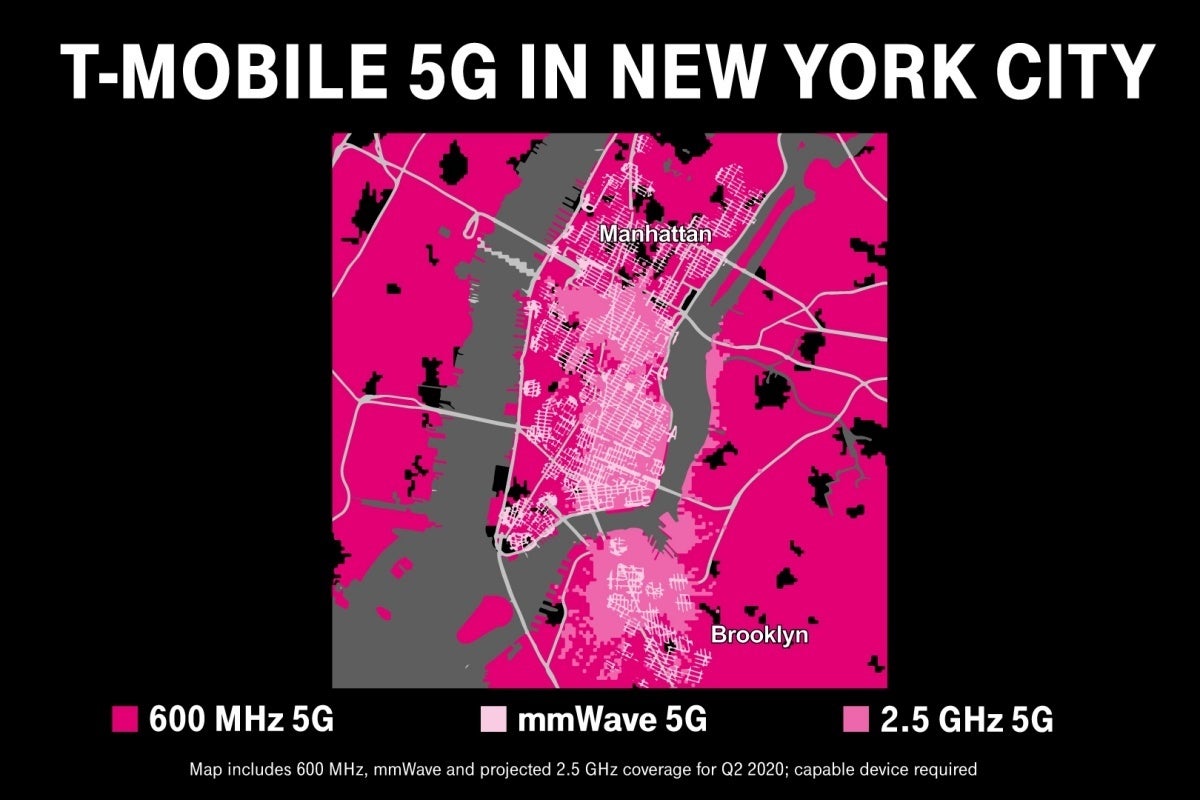T-Mobile to merge Sprint's 5G network coverage faster with an edge over Verizon

New York is the first of many metro areas that will be covered by the new T-Mobile's 5G by year's end
There will be a lot of network to take advantage of, too. The combined band holdings of T-Mobile and Sprint have 319 MHz of spectrum holdings even without the fast mmWave bands. That's already double the AT&T and almost triple the Verizon amount. In the fast high-bands, where all the gigabit speeds magic happens, the mmWave spectrum holdings of T-Mobile and Sprint are 1,160 MHz, second only to Verizon's.
Sprint's 2.5GHz band merger into T-Mobile's 5G network
We already reported that the post-merger promise to integrate the two 5G networks is bearing fruit in two cities - New York and Philadelphia - and, if you have the Galaxy S20+ and S20 Ultra, or Sprint's S20 5G, you can now have your triple-layer cake there... and eat it.
It turns out, however, that folding Sprint's 5G spectrum into the new T-Mobile's coverage map will happen sooner than we were led to believe. Speaking at an investor conference on Monday, T-Mobile's CTO Neville Ray divulged that the mid-band deployment will happen much faster than expected, coronavirs crisis and all:
We will deploy across thousands of sites this year, and I think that’s going to surprise our competition. They think this is going to take us kind of another two to three years to get some momentum and speed, and it won’t. We already have momentum.
How come? Well, a lot of the 5G retrofitting is done at already existing sites and towers with 4G/5G infrastructure. In addition, the T-Mobile ex-CEO John Legere's unbridled optimism helped Big Magenta buy permits and lay down infrastructure for a combined network all this time while the merger was up in the air with regulatory approval challenged and lawsuits coming left and right.
You know, like this post here from a T-Mobile engineer on top of an existing site in the beginning of the coronavirus lockdown scare, retrofitting 5G equipment.
Combined T-Mobile/Sprint 5G network coverage and speeds in New York and Philadelphia
The time spent on merger prep is paying off handsomely now, and Mr Ray mentioned at the investor talk yesterday that the new T-Mobile is moving at the pace of about a 1000 sites a month going into May and June which means that, by year's end, most major metro areas will be covered with the combined T-Mobile/Sprint 5G network layer cake.
Currently, even by just using using 50-60 megahertz of Sprint's 2.5 GHz spectrum in the first two combined markets that were switched on - New York and Philadelphia - T-Mobile was able to achieve speeds that are five times faster than the 4G LTE fallback.
Granted, the mid-band 2.5GHz spectrum isn't as fast as those gigabit mmWave speeds that the high bands offer and which Verizon's 5G network is entirely built out on, but the signal travels much farther, for that matter. When it comes to Philadelphia, in particular, the area that the new combined T-Mobile/Sprint 5G network covers, is two and a half times larger than the Verizon 5G network's entire footprint nationwide.
Thus, while T-Mobile spent the past decade catching up to Verizon and AT&T in terms of 4G LTE coverage and services, commencing and concluding a plan price war in the meantime, it now has every chance to pull ahead in the next-gen 5G network coverage. "We want to lead the way. We’ve spent the last seven years getting even," said Mr Ray, and for us end users it may only mean invigorating competition for our hard-earned 5G dollar.










Things that are NOT allowed: